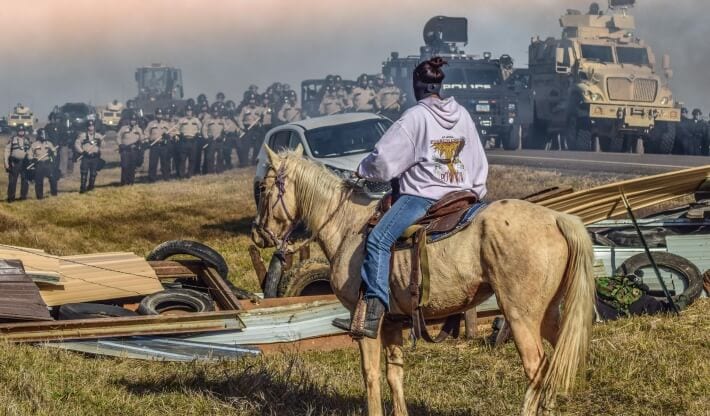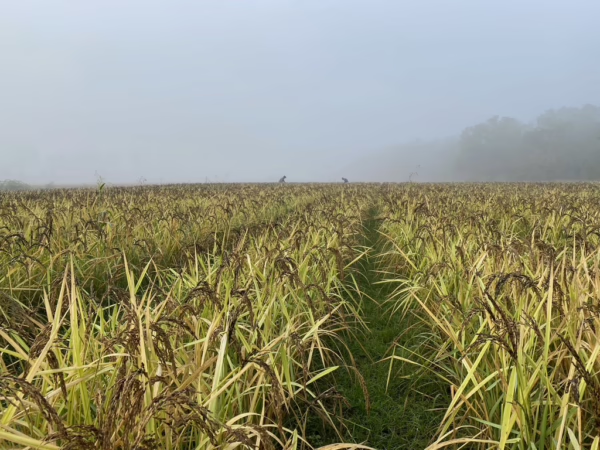Standing Rock is an Indigenous-led resistance through the power of collective prayer and ceremony. Its context is the 500-year-long impact of colonialism on First Nation People, which inflicted one of the largest genocides in human history, alongside mass invasion of Native lands, a litany of broken treaties, and legislated cultural oppression. Like so many other tribes, the Souix have endured removing children from their homes, forced Christianized education at boarding “schools,” and ongoing marginalization of Indigenous rights. This generational domination remains firmly in place, illustrated by the State of North Dakota attempting to force, through intimidation and violence, the tribe to accept what white society, a few dozen miles away at Bismarck city, rejected: the Dakota Pipeline through the heart of their community. The assurance of Energy Transfer Partners, who are developing the pipeline, that there will not be an oil spill into the Missouri River, which the line traverses, are empty given that that there have been hundreds of pipeline spills in the USA each year, including those from Sunoco Logistics, the future operator of the DAPL.
Standing Rock, one of the most unique gatherings ever, is a front line against the most powerful corporations ever, the oil industry. Certainly, this is the first time, since the Battle of Little Bighorn in the 1800’s that the three divisions (Lakota, Dakota and Nakota) of the Oceti Sakowin have come together, alongside over 30 other Indigenous Nations. This gathering of Indigenous Nations from all over Turtle Island (the Native name for North America) has not been known in historical memory. The tribes represented have been joined by First Nation peoples from South America, New Zealand, and beyond, and allies from around America and further afield. Also joining are over two thousand military veterans who have vowed to protect this courageous and determined community.

What one is bequeathed through the gift of Standing Rock is a clarified, strong, heart, burning with a light of commitment and hope in the face of incalculable odds.
At the heart of this resistance is commitment to break the cycles of violence born of a colonial mindset, which feels entitled to extract for self-benefit regardless of the impact. This mindset is now the front line everywhere, within and around us all. Increasingly, our choices will be influenced either by a colonizing, psychopathic corporate agenda servicing extortionate amounts of wealth for a minuscule percent of the global population, or they’ll contribute to a necessary resistance upon which our survival now depends.
Standing Rock offers an indigenous template for wise choice from seven Lakota values around which the camp orientates itself. These values, elaborated on by what I experienced and heard at Standing Rock, speak to collective resistance as both an inner training as well as guidelines for family, community, society, and business:
- Prayer: Honor and respect the sacred within all life, which includes nature, the earth, the elements of fire, water, air, and those living beings that are not two legged. (The reductive term animals, is not in indigenous language.) Purify the heart, connect with ancestors, and the overall indwelling spirit of creation while aligning within community through ceremony. This involves resistance as ceremony.
- Respect: Respect begins with deferential listening, and from that, a willingness to shift into new ways internally and behavior externally. It means not pushing ego agendas and strategies. Instead be willing to listen to wise elders, to feedback, to what is needed for the overall good of the community.
- Compassion: Take care of one another. Be compassionate towards ones self, and to self and others when making mistakes. The stronger let the physically weaker go first, for example, at meals, the elders, women and children go first. As a practice, step aside from assuming entitlement due to race, gender, class, wealth, and instead tune into the needs of the marginalized and vulnerable.
- Honesty: Be true and authentic with each other, while being self honest about our conditioning and how that plays out in ways that generate harm, even subtly, to others and the environment.
- Generosity: Put in more than you take out. Generosity is not just sharing physical goods, but is essential to generating sustainable life for all. It is the direct opposite of colonization, which is based in domination and ownership at the expense of others.
- Humility: Be grounded in your own being, while checking your expectations of others and what is around you. Hold off from pushing your agenda, particulalry if it is dominating the space with “I have a better way”, “My idea is best.” Be sensitive to internalized colonized conditioning, and be willing to own it.
- Wisdom: We all carry wisdom within us, but within the context of Indigenous or Elder wisdom spaces, listen and be guided by the understandings offered. Resist an “extractive” mindset, or cultural appropriation, of what is not offered. Be respectful of elders and learn to listen to all voices, even those you don’t agree with.
At the heart of this sacred, prayerful and ceremonial resistance at Standing Rock is a commitment to complete non-violence. My understanding of this, from what I witnessed, heard, and experienced, is that there is an invitation to align with a deeper power. This power, articulated as guidance of ancestors, forces of nature, and the overall guiding intelligence of the Great Spirit, pulses within us. At Standing Rock, I experienced my heart being stripped down to its essential rawness. In place of socialization strategies, what arose was strength of authenticity, of sharing, of camaraderie, and a wonder at the resilience of human beings rising up.
Here’s some of what I heard from an Indigenous man who is a Water Protector and leader of the heart and spirit.
What should be remembered about Standing Rock is that it began with children calling us to pray with them. Elders too. We must mean and do what we say. Fighting from violence disrespects the ancestors. The ancestors are fighting the battle also, and they need us to be here without violence. You must pray for yourself, to take out your pain and have love put in your heart instead. As we unify with nature, she will heal us. Respect Mother Earth.
He also said,
One day, at the height of the Iraq War, an Elder Grandmother prayed to the ancestors at the sacred fire to ask that the war stop. They responded by saying to her that her prayer was a good prayer, but it was not enough. That everyone must pray to stop war. We are at a precipice. Everyone must now pray.
 Water is Life. This meme is the underlying stream of consciousness at Standing Rock. The pipeline threatens the clear and beautiful waters of the Missouri River. Every morning, as day broke, the pre-dawn circle around the sacred fire, buoyed by shared wisdom from Elders and water protectors, enacted a ceremonial and collective walk to the bank of the river. There, offerings are made. Sometimes formations of geese fly across the limpid snow grey sky as the still glass waters and spirit of the Missouri responds. It is felt as a subtle jubilant uplift within the heart. This earth is alive and she feels our intentions, our actions, and our hearts.
Water is Life. This meme is the underlying stream of consciousness at Standing Rock. The pipeline threatens the clear and beautiful waters of the Missouri River. Every morning, as day broke, the pre-dawn circle around the sacred fire, buoyed by shared wisdom from Elders and water protectors, enacted a ceremonial and collective walk to the bank of the river. There, offerings are made. Sometimes formations of geese fly across the limpid snow grey sky as the still glass waters and spirit of the Missouri responds. It is felt as a subtle jubilant uplift within the heart. This earth is alive and she feels our intentions, our actions, and our hearts.
 Everyday we use water. We depend on it for life, and yet we entirely take it for granted. One late afternoon, a woman spoke at the fire. She had come from Flint, Michigan to join forces. She spoke of poisoned water in her city, of people drinking and having their teeth dissolve, of people getting sick, dying, and of her own infertility and pain at not being able to mother children due to the poisoned water.
Everyday we use water. We depend on it for life, and yet we entirely take it for granted. One late afternoon, a woman spoke at the fire. She had come from Flint, Michigan to join forces. She spoke of poisoned water in her city, of people drinking and having their teeth dissolve, of people getting sick, dying, and of her own infertility and pain at not being able to mother children due to the poisoned water.
Standing Rock is not just about Standing Rock it is about everywhere and our struggle to reclaim the sacredness of water, of the elements, and of the Earth. It speaks to our need to reconnect with each other in more direct, generous, authentic and respectful ways, and it speaks to our true spirit, which seeks to release from the mechanistic, disassociated, drudgery of a desacralized life, by undertaking acts of loving service and sacrifice.
Bring it Home! Not everyone can get to Standing Rock, and not everyone at Standing Rock can go on the front lines. But every one of us must now pay heed to what is unfolding there, because all of us need to play our part to ensure a livable planet for future generations. We can’t rely on politicians or other leaders, instead we have to all pull together. We are on a precipice and the lights are going out. We are losing the Arctic, the Great Barrier Reef, the great forests, most wild life, and we are being threatened by a craven political and corporate agenda that cares for no one, except it’s own profit. Those who crave money will find out soon that they cannot eat their money. Those standing at Standing Rock stand for them too, and for their children and their grandchildren.
 We do this for all of us. The Army Corps of Engineers, who claim the land of Oceti Sakowin Standing Rock, have stated the intention of evicting the camp on December 5th. It now looks like the peaceful Water Protectors will be confronted by a highly militarized police force, alongside a private, mercenary army on behalf of the State, the pipeline and the oil company, who have already proved their capacity for shameful, wonton violence. Chief Arvol Looking Horse has asked us to jointogether in prayer and ceremony. To do so can help to help avert this potential catastrophe. Please do what you can.
We do this for all of us. The Army Corps of Engineers, who claim the land of Oceti Sakowin Standing Rock, have stated the intention of evicting the camp on December 5th. It now looks like the peaceful Water Protectors will be confronted by a highly militarized police force, alongside a private, mercenary army on behalf of the State, the pipeline and the oil company, who have already proved their capacity for shameful, wonton violence. Chief Arvol Looking Horse has asked us to jointogether in prayer and ceremony. To do so can help to help avert this potential catastrophe. Please do what you can.
Whatever happens on that fateful day: whether Standing Rock and its incredible blazing heart stands of falls, what is assured is that voluminous, potent seeds are fast growing in support of collective resistance. The Indigenous People are showing the way, as have many oppressed people throughout history, and for this, words of gratitude seem paltry. What one is bequeathed through the gift of Standing Rock is a clarified, strong, heart, burning with a light of commitment and hope in the face of incalculable odds. This then, is our offering of gratitude. To pick up the flame of hope, and to carry it long into the shadowy night that is fast encroaching us all.

Thanissara is Anglo/Irish and originally from London. She was a Buddhist nun for 12 years in the Forest School of Ajahn Chah and has taught meditation internationally the last 25 years. She is co-founder of Dharmagiri, a small meditation center in the Southern Drakensberg in South Africa which also initiates and supports local community engagement projects. Thanissara is author of The Heart of the Bitter Almond Hedge Sutra, and co-author, with Kittisaro, of Listening to the Heart: A Contemplative Journey to Engaged Buddhism. Her most recent book Time To Stand Up: An Engaged Buddhist Manifesto for Our Earth, was released in August 2015 as part of the North Atlantic Books Sacred Activism Series.







